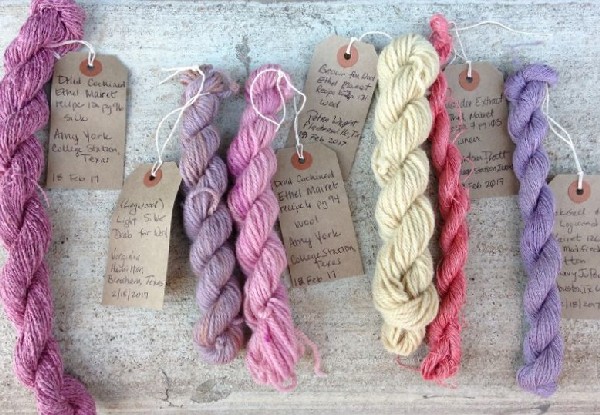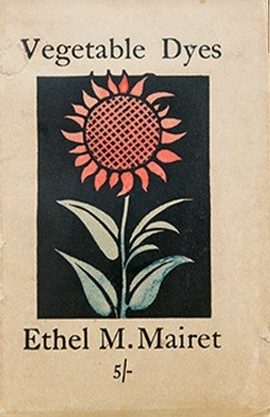Dyeing with Ethel Mairet in Navasota, Texas
By Virginia Hamilton
"The aim of crafts is to make life, and no trouble must be spared to reach that end." - Ethel Mairet
Ethel M. Mairet (1872-1952) was a weaver and a dyer who settled in Dichtling, England, where an active crafts community was located. There she established a school of weaving to provide a place where weavers could learn and share. In 1916, she published A Book on Vegetable Dyes, (published by Douglas Pepler at the Hampshire House Workshops, Hammersmith, London, England). In her introduction to this book Mairet wrote, "Dyeing has almost ceased to exist as a traditional art. In this 20th century, the importance of colour in our lives seems to be realized less and less. It has been forgotten that strong and beautiful colour, such as used to abound in all every day things, is an essential to the full joy of life" (p. 1).
Despite the work and the challenges of dyeing with plants and other natural materials, she felt the resulting colors were far superior to those produced with dyes created in the chemist's lab, and well worth the effort. "I would say to dyers, do not be satisfied with seeing beautiful coloured stuffs in museums. It is possible still to get them, and to live with a piece of good colour is of much more use than occasional hours spent in museums" (p. 11).
In 2016, the Dichtling Museum of Art and Craft celebrated the 100-year anniversary of the publication of her book by conducting a joint exhibition and project on natural dyeing. Craftspeople from around the world were invited to use her recipes to dye fiber and send it to the museum for display.
Jo Pointdexter, a fiber artist in Houston, Texas, discovered this project while perusing the internet and, together with WC Mercantile, a fiber shop in Navasota, Texas, launched a local project to participate. Five of us who have taken natural dying classes with Jo met on a Saturday in February to try out some of the recipes. Prior to this, Petra Wright of WC Mercantile had looked through the recipes and helped Jo determine what dye materials we would use. A challenge, she said, was interpreting the recipes which are, at times, vague on proportions. Some of the original recipes used dyestuffs (such as some lichens) and mordants (such as chrome) that are no longer considered safe for hobbyist use. In addition, we made some educated guesses in order to convert the "recipes" to local dye plant materials and to the small scale in which we were working.
We dyed using fiber samples provided by the Dichtling Museum and the following recipes from A Book on Vegetable Dyes:
The museum requested that each sample be tagged as shown in the photo below, so that all samples hanging in the exhibit would show the name and location of the dyer and the dye recipe used.
Cochineal on silk, Logwood on wool, Cochineal on wool, Pine needles on wool, Madder on linen, Oak gall with logwood on wool

Lessons learned in our project:
At the end of the day, all of us involved agreed it was fun and worthwhile. In addition to the thrill of pulling our dyestuffs out of the vats and watching as the colors revealed themselves, we were inspired to learn about Ethel Mairet and her recipes, and we felt privileged to participate in a project with a greater community of natural dyers. Our dye samples are now on display at the museum in Dichtling with all the others from around the world.
For more information on Ethel Mairet and this project, see the following:
http://www.ditchlingmuseumartcraft.org.uk/naturaldyeproject/
https://www.youtube.com/watch?v=NqiWz5Zrnmw
A photocopy of Ethel Mairet's book is available here:
https://archive.org/details/bookonvegetabled00mairrich
An electronic copy of her book can be downloaded here:
http://www.gutenberg.org/files/50079/50079-h/50079-h.htm
Virginia Hamilton is an avid knitter who enjoys dyeing fiber with plant materials grown in her garden. She is also a freelance editor and instructional designer. She lives, works, knits, and gardens in Central Texas with help from her husband and her two trusty dogs.
 Turkey Red Journal
Turkey Red Journal
